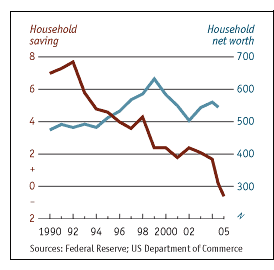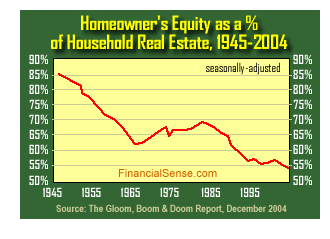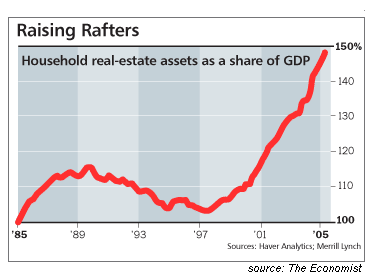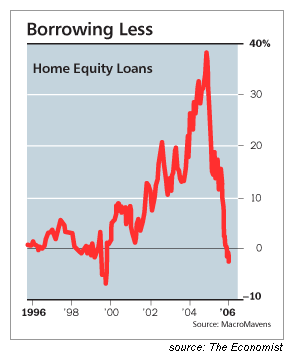

|
| weblog/wEssays archives | home | |
|
The Housing-Savings-Recession Connection (May 11, 2006)  You may have noticed that I always source data from either official government
sites or mainstream media sources. Why? To avoid sounding like just another panicky
doom-and-gloomer. In other words, if The Economist, Wall Street Journal, Barron's, BusinessWeek
and Foreign Affairs are reporting the same points, then it's much more difficult
to dismiss it all as so much balderdash. It depends, of course, on one's definition of
doom-and-gloom; for some, it's planetary disaster, while for others it's a deep economic
recession. I consider the latter not so much doom-and-gloom as simply part of
the typical business cycle. It is a healthy and indeed, necessary tonic to over-borrowing
and over-spending.
You may have noticed that I always source data from either official government
sites or mainstream media sources. Why? To avoid sounding like just another panicky
doom-and-gloomer. In other words, if The Economist, Wall Street Journal, Barron's, BusinessWeek
and Foreign Affairs are reporting the same points, then it's much more difficult
to dismiss it all as so much balderdash. It depends, of course, on one's definition of
doom-and-gloom; for some, it's planetary disaster, while for others it's a deep economic
recession. I consider the latter not so much doom-and-gloom as simply part of
the typical business cycle. It is a healthy and indeed, necessary tonic to over-borrowing
and over-spending.
I used to be rather sanguine about the future until I began looking at the data--nasty habit, that, looking for clues to the future in data and charts. It really plays havoc on your most cherished illusions, prejudices and ideological truisms. With that flourish of trumpets, let's start with economist Martin Feldstein's article in the current issue of Foreign Affairs, The Return of U.S. Savings. 
The U.S. savings rate has been falling for decades. But that downward trend will likely soon be reversed, as factors such as rising mortgage interest rates force Americans to start saving more. The change will ultimately be for the better, but in the short term it could cause serious problems for the United States and its trading partners unless they start preparing immediately.Let's see if these charts align with Feldstein's assessment. The first chart shows both the steady decline in savings into negative-number territory--that is, Americans are spending more than they earn, including wages, dividends and interest--and the recovery in household wealth from the 2000 dot-com debacle. That increase in household wealth enabled the borrowing spree which has driven consumer spending up even as savings sank to negative numbers. 
Though real estate has risen at astonishing rates since 2000, the second chart reveals that home equity has actually been declining. How is this possible? Easy--the magic combination of rising home equity and loose money which stimulated huge consumer borrowing. Here is clear evidence of that massive borrowing. Even as interest rates dropped to multi-decade lows, the percentage of peoples' incomes devoted to debt service has risen to new heights, as shown in chart 3. How can we be sure that it's rising real estate values which are underpinning all this borrowing? Look at chart 4. Even as GDP has risen steadily and the stock and bond markets have soared from their 2002 lows, housing has risen to an uprecedented percentage of GDP, far exceeding the value reached at the last boom-bust cycle top in 1990.  Chart 5 shows that the immense extraction of home equity which has been sustaining
consumer spending has come to an abrupt end. As house prices stabilize, borrowing costs /
mortgage rates rise and household debt
payments reach historically unsustainable levels, borrowing ceases.
Chart 5 shows that the immense extraction of home equity which has been sustaining
consumer spending has come to an abrupt end. As house prices stabilize, borrowing costs /
mortgage rates rise and household debt
payments reach historically unsustainable levels, borrowing ceases.
This is the point at which Feldstein predicts American households will start saving by restraining their spending. As a corollary to that reduction in consumer spending and a rise in savings, we might also posit that households will also begin paying down debt--a trend which we can see in chart 3 as the economy slowed in the early 90s. For more on these trends, check out these articles from BusinessWeek: Why more households are feeling flush Home is where the worth is What's the net result of such a massive reallocation of income to savings and repayment of debt, away from consumption? It's called a balance-sheet recession: Although repairing balance sheets is the right and responsible thing to do, when many simultaneously shift their priorities from spending maximization to debt minimization, Adam Smith's Invisible Hand reverses its normal direction and shrinks both the economy and the money supply. (edited excerpt)For more on the phenomena, check out Japan's balance sheet recession (BusinessWeek) So here's the Housing-Savings-Recession Connection. As borrowing costs dropped and housing values rose, it made little sense to save money and all the sense in the world to borrow huge sums of "free lunch" money from all that home equity wealth and spend it freely. Now that interest rates are rising and housing prices are leveling or dropping, people have stopped borrowing. If Feldstein (and history) is right, households will start saving again, and using some of those savings to pay down debt. This will trigger a balance-sheet recession, in which consumers "repair" their balance sheet by spending less and paying down consumer debt. Is there any other possible interpretation of these charts? For more on this subject and a wide array of other topics, please visit my weblog. copyright © 2006 Charles Hugh Smith. All rights reserved in all media. I would be honored if you linked this wEssay to your site, or printed a copy for your own use. |
||
| weblog/wEssays | home |